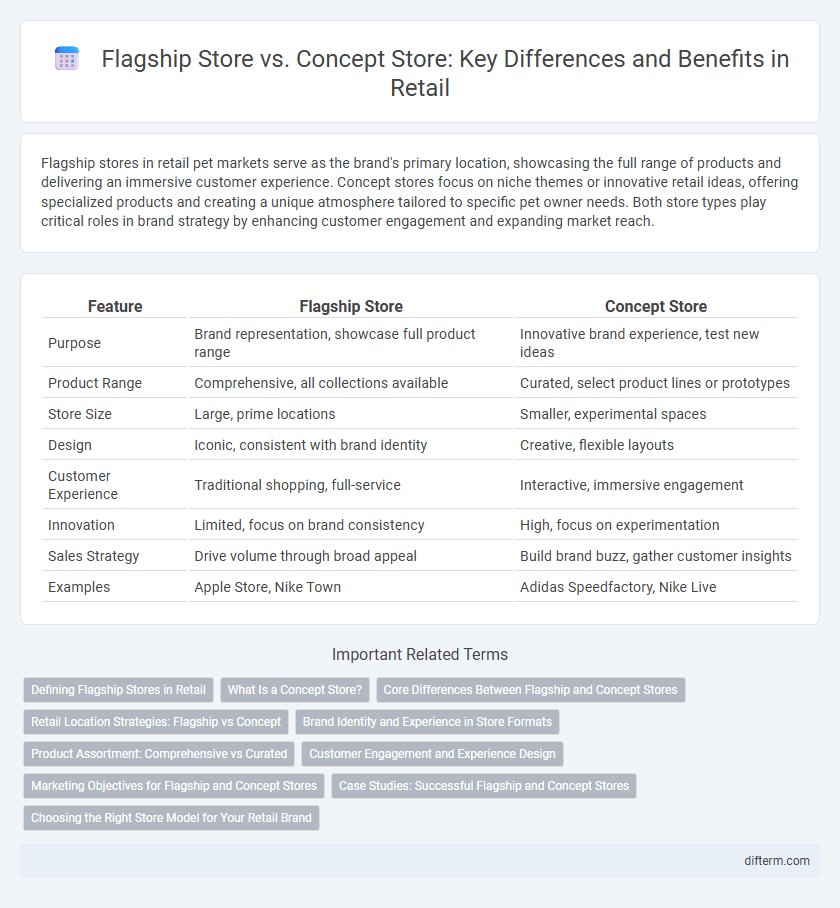Flagship stores in retail pet markets serve as the brand's primary location, showcasing the full range of products and delivering an immersive customer experience. Concept stores focus on niche themes or innovative retail ideas, offering specialized products and creating a unique atmosphere tailored to specific pet owner needs. Both store types play critical roles in brand strategy by enhancing customer engagement and expanding market reach.
Table of Comparison
| Feature | Flagship Store | Concept Store |
|---|---|---|
| Purpose | Brand representation, showcase full product range | Innovative brand experience, test new ideas |
| Product Range | Comprehensive, all collections available | Curated, select product lines or prototypes |
| Store Size | Large, prime locations | Smaller, experimental spaces |
| Design | Iconic, consistent with brand identity | Creative, flexible layouts |
| Customer Experience | Traditional shopping, full-service | Interactive, immersive engagement |
| Innovation | Limited, focus on brand consistency | High, focus on experimentation |
| Sales Strategy | Drive volume through broad appeal | Build brand buzz, gather customer insights |
| Examples | Apple Store, Nike Town | Adidas Speedfactory, Nike Live |
Defining Flagship Stores in Retail
Flagship stores in retail serve as the brand's premier location, showcasing the full product range and embodying the brand's identity through immersive design and customer experience. These stores are strategically located in high-traffic areas to maximize visibility and drive brand awareness. Flagship stores often act as innovation hubs, introducing new products and exclusive offerings that set retail trends.
What Is a Concept Store?
A concept store is a retail space designed to showcase a curated collection of products that embody a specific theme, lifestyle, or brand philosophy, offering customers an immersive shopping experience beyond traditional merchandise. Unlike flagship stores, which primarily emphasize brand identity and flagship product ranges, concept stores integrate art, design, and culture to create a unique environment that encourages exploration and emotional connection. These stores often feature limited-edition items, experiential displays, and collaborative installations to differentiate themselves in a competitive retail landscape.
Core Differences Between Flagship and Concept Stores
Flagship stores serve as the primary retail locations showcasing a brand's full product range and identity, often situated in prime locations to maximize visibility and brand presence. Concept stores focus on delivering curated, unique shopping experiences through innovative layouts and limited product selections, emphasizing trends and lifestyle over volume. The core difference lies in flagship stores prioritizing comprehensive brand representation and sales, while concept stores prioritize experimentation and consumer engagement.
Retail Location Strategies: Flagship vs Concept
Flagship stores serve as a brand's premium retail location, offering the full product range, immersive brand experience, and strategic visibility in high-traffic areas to maximize customer engagement. Concept stores focus on innovation and experimentation, showcasing limited editions, cutting-edge designs, and localized assortments to test market trends and deepen niche appeal. Retail location strategies leverage flagship stores for brand identity reinforcement while using concept stores to gather consumer insights and adapt quickly to evolving preferences.
Brand Identity and Experience in Store Formats
Flagship stores serve as the primary retail location embodying a brand's identity through expansive layouts, premium design elements, and comprehensive product ranges that reinforce brand heritage and prestige. Concept stores prioritize immersive, innovative experiences by showcasing limited-edition collections or new product lines, fostering customer engagement with interactive displays and tailored sensory elements. Both formats enhance brand presence, with flagship stores emphasizing consistency and scale, while concept stores drive experimentation and consumer connection.
Product Assortment: Comprehensive vs Curated
Flagship stores typically offer a comprehensive product assortment, showcasing the brand's full range to create a broad shopping experience and maximize customer engagement. Concept stores feature a curated selection of products, emphasizing unique, trend-driven, or thematic items to highlight innovation and brand identity. This curated approach allows concept stores to create exclusive experiences that attract niche markets and foster deeper brand connections.
Customer Engagement and Experience Design
Flagship stores serve as brand ambassadors with extensive product ranges and immersive environments designed to maximize customer engagement through interactive displays and personalized services. Concept stores focus on innovative experience design by showcasing curated, thematic collections that encourage exploration and emotional connection with the brand's identity. Both formats leverage sensory elements and technology integration to enhance customer journey, yet flagship stores emphasize brand heritage while concept stores prioritize experiential storytelling.
Marketing Objectives for Flagship and Concept Stores
Flagship stores aim to maximize brand visibility and reinforce brand identity by showcasing the full product range and delivering an immersive customer experience, driving long-term brand loyalty. Concept stores focus on testing new ideas, trends, and product innovations to attract niche customer segments and generate valuable market insights for future marketing strategies. Marketing objectives for flagship stores center on brand prestige and sales volume, while concept stores prioritize customer engagement and brand experimentation.
Case Studies: Successful Flagship and Concept Stores
Nike's flagship store in New York showcases immersive technology and interactive spaces that enhance customer engagement and brand storytelling, driving sales and loyalty. Apple's concept stores, designed to test innovative retail designs and customer experience models, have successfully influenced global store layouts and boosted product launches. Both store types leverage location, design, and customer experience to create impactful brand presence and increase market share.
Choosing the Right Store Model for Your Retail Brand
Flagship stores serve as the primary retail location, showcasing the brand's full product range and creating a powerful brand presence in high-traffic areas, ideal for driving maximum visibility and sales. Concept stores focus on experimental and limited offerings, designed to test new ideas and engage niche customer segments with immersive, innovative experiences. Selecting the right model depends on your retail brand's goals: flagship stores reinforce brand identity and mass appeal, while concept stores foster innovation and targeted customer engagement.
Flagship Store vs Concept Store Infographic

 difterm.com
difterm.com